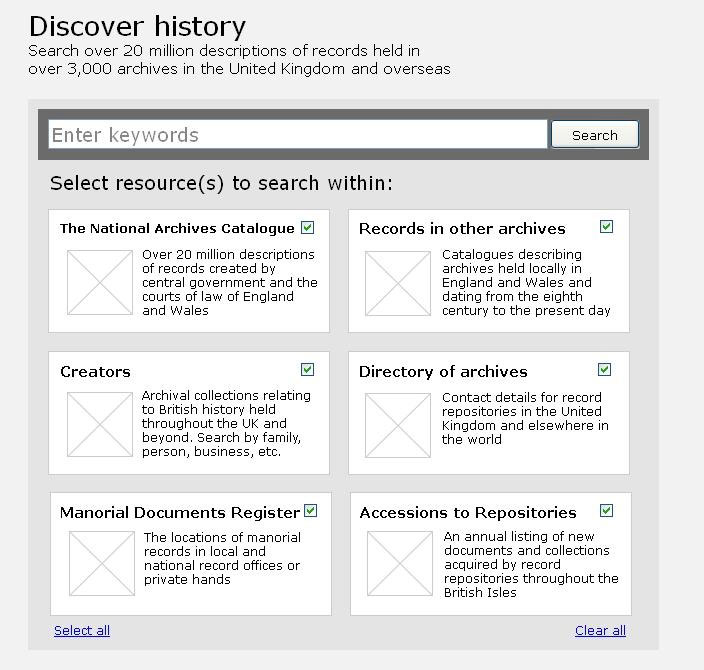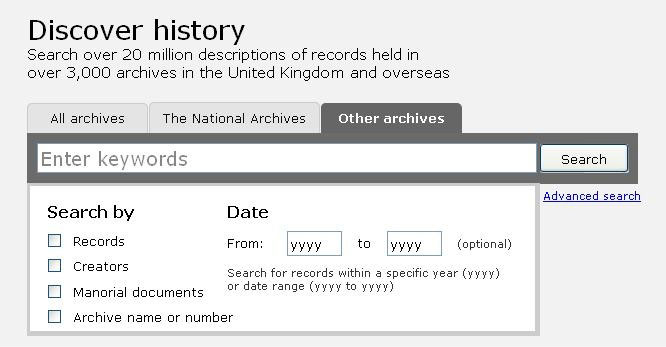What is the Finding Archives project?
 For the last 18 months we have been working on Finding Archives which is part of the Discovery project. Finding Archives focuses on the bringing together information describing records held in other archives with the information about The National Archives records so that users can access this in one place, simply and easily-a ‘one stop shop’ for access to records relating to UK history wherever they are held.
For the last 18 months we have been working on Finding Archives which is part of the Discovery project. Finding Archives focuses on the bringing together information describing records held in other archives with the information about The National Archives records so that users can access this in one place, simply and easily-a ‘one stop shop’ for access to records relating to UK history wherever they are held.
Finding Archives focuses on the National Register of Archives (NRA), Manorial Documents Register (MDR), ARCHON Directory, Access to Archives (A2A), Accessions to Repositories and the Hospital Records Database (HOSPREC). These services currently provide descriptive and access information about millions of records held in over 2500 archives in the UK and overseas. At the moment, Discovery displays The National Archives’ catalogue data and digital records. The value of combining Finding Archives data with information about over 20 million records held at The National Archives is enormous.
So in phase one we reviewed these resources and gathered feedback from both users (people who use the resources now and future users) and contributors (archives that provide us with information about their collections). We used this information to make informed recommendations for the future.
We held focus groups and ran an online survey and collected feedback from staff in the Archives Sector Development team, which manages these services at The National Archives. This gave us over c.400 detailed requirements and c. 50 high level requirements for use in the development phase.
If you want to find out more about this you can read the summary report that was produced last year. Visit the Finding Archives page on the Archives sector section of the website.
So where did we go from there?
Taking all of this feedback into account has given us a great steer on what’s important to users of these resources and the archives that contribute to them.
There are several big pieces of work which need to be completed before the results are visible on Discovery. The structure of all of these resources is very different and developing a system that can store and present this information to users is just one, very big, part of it.
We also need to make it easier for contributing archives to give us or allow us access to their data so that Discovery remains up-to-date. This is a big challenge as archive services and their catalogue information can be vastly different. We work with small scale archives or private owners right through to large county record offices and national institutions. We need to be able to cater for all of these, so that we can give users the up to date information they need, regardless of where records are held.
So, for the last six months we have been spending lots of time reviewing our requirements, looking at the content and the structure of the current resources and doing some initial work on moving some content into the Discovery technical architecture so that when the time comes it can be presented via Discovery.
Whilst all this has been going on, we have also been doing lots of work with Tony Russell-Rose, director of UXLabs.
Tony has been helping us to develop design concepts which will, for example, allow Discovery to present information about a single photo of Winston Churchill ‘at No 10 Downing Street in March 1945 sitting at desk, cigar in hand’ held at The National Archives alongside the description of core correspondence and papers held at Cambridge University: Churchill Archives Centre. The key bit is ensuring you find the records you are looking for, if they exist.
User testing and what we learned
Tony and Paul Lamey, our Customer Research Manager, recently went to Birmingham to spend the day at the Birmingham Museum and Art Gallery, where staff very kindly provided them with the space to do user testing with both users and archive sector contributors. They also followed this up with some on site testing at Kew.
Development of the Discovery front end (the bit that users see) for finding archives content is quite complicated because of the different services being brought together. Tony has broken development into workable chunks – what he calls the opening, middle and end games – your initial search, your refinements and then your final payload i.e. what you are looking for.
They tested some of the initial opening games and this has informed development. At this stage, ARCHON and existing Discovery content were used but we are working on the NRA at the moment.
There were six initial views to test and here are some examples of these opening games:
The resource gallery
In this model, current services are displayed as individually searchable resources
There is contextual information about what each resource is and the user can select which resource to search within.
Though users like this for its clarity and guidance, some struggled with the functionality.
One box
This model which is similar to the Google© search box did not test as well as some of the other options which provide more contextual information about what you are searching.

One box
Tabbed search
This model was popular in the testing as it allows you to switch between searching The National Archives / other archives / all content. We know the labels need improving and were given feedback about which tab should be default.
Auto tabs
This is similar to the tabbed search but is context-sensitive. When you choose either of the tabs further options appear automatically below.
We learned from the testing that tabs are popular and that we need to work on guidance and labelling so users understand how to retrieve content from Discovery.
What’s next?
Now that we have had really useful feedback this will help us to tailor the current designs so that they work better. They will allow us to develop a specification for how Discovery will need to develop technically to deliver its new functions. We will be focusing on this over the next few months, expanding the designs to include other content including Access to Archives and should hopefully have some more designs to share soon. So watch this space…
We are also looking at how we might make information in Discovery available for reuse through the Open Government License and will be picking this up with other archives in the next six months.



